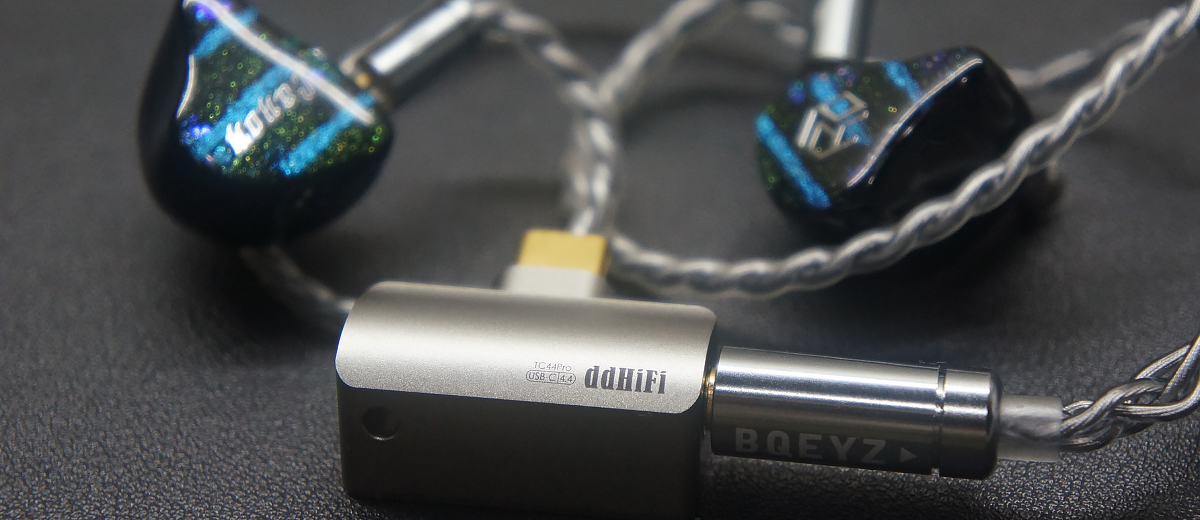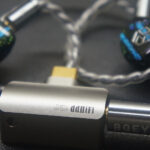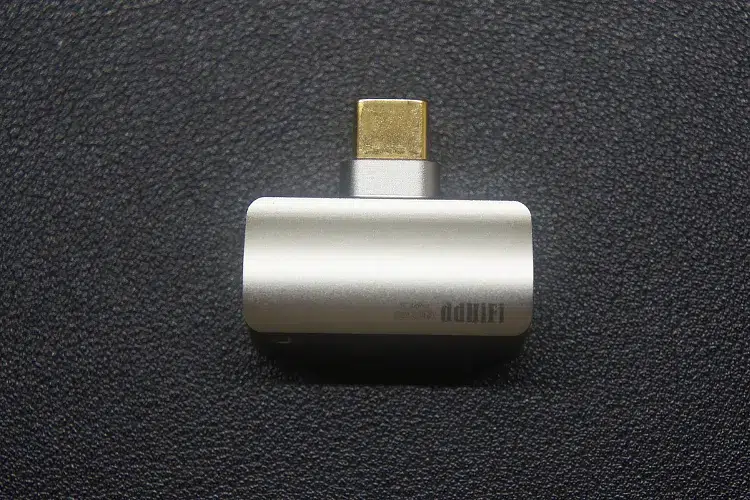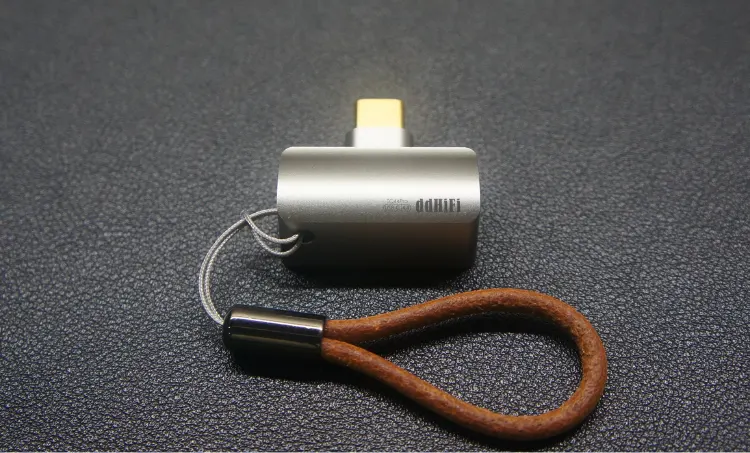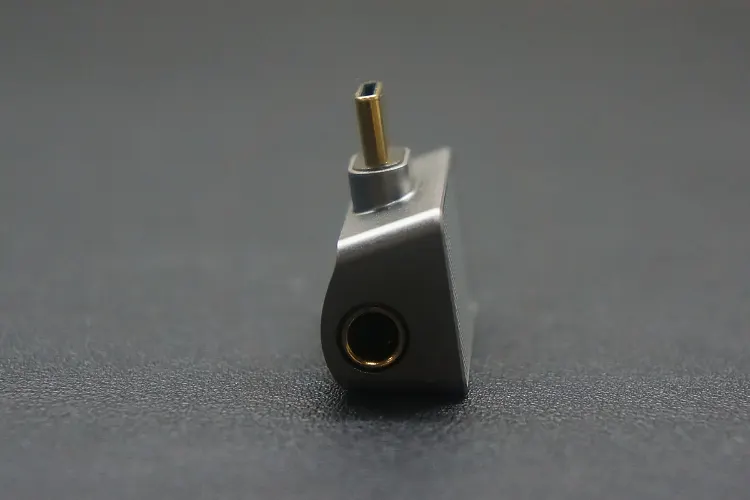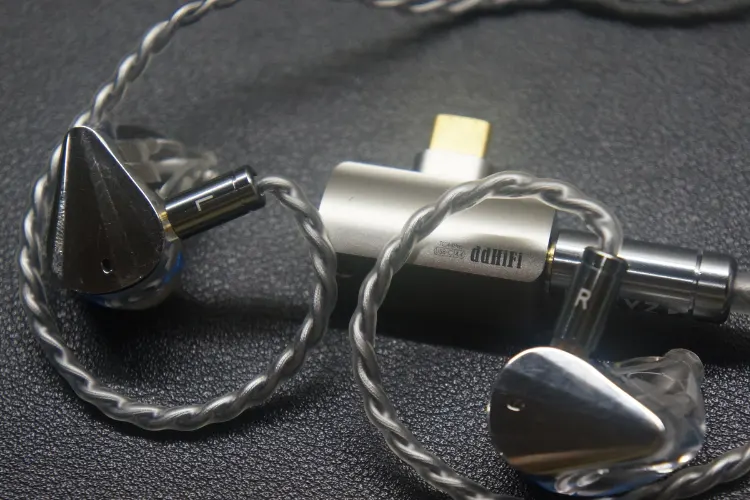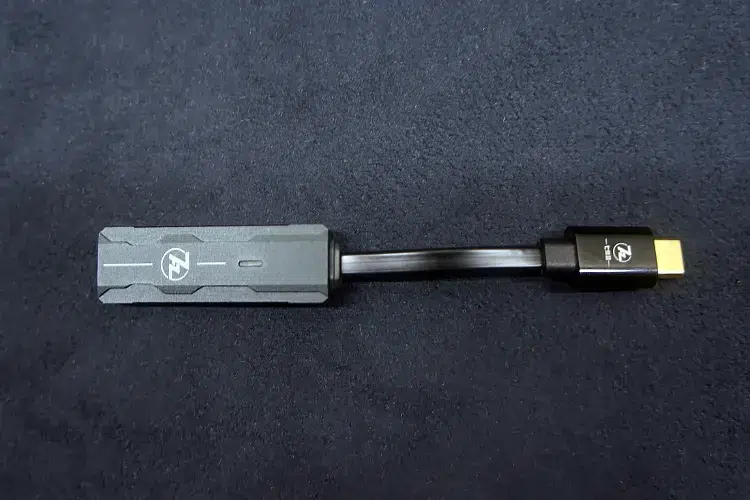We review the ddHiFi TC44Pro, which is a compact 3rd generation balanced dongle DAC compatible with both Android and iOS Lightning devices. It is priced at $79.99.
Disclaimer: This is a sample that was sent to us in exchange for our honest opinion. Headfonics is an independent website with no affiliate links. Many thanks to ddHiFi for their support
You can read about previous ddHiFi products we have previously featured on Headfonics here.
Note, that this article follows our latest scoring guidelines which you can read up on here.
ddHiFi is somewhat of an ‘indie brand’ to date but hardcore portable-focused audiophiles have come to associate ddHiFi for their extremely high quality and overbuilt adapters, cables such as the M120B, and a vast array of dongles such as the TC44C.
All are designed to improve the overall usability of one’s portable audio setup with minimal expenditure.
This time, ddHiFi has released the TC44Pro, an extremely compact 4.4mm balanced DAC. Let’s find out if big things really do come in small packages.
Tech Highlights
The ddHiFi TC44Pro is a balanced-only portable DAC/AMP making use of dual Cirrus Logic CS43131 DAC chips that can natively decode up to PCM 32bit/384kHz and DSD256 formats. Its balanced output is capable of up to 120mw into a 32Ω load.
It is not the first, nor is it the cheapest dongle DAC to make use of this DAC topography, however, it may very well be one of the most portable executions of the configuration.
Additionally, the entire Dongle and its connectors are constructed onto a single PCB, eliminating the need for cables that could introduce noise, points of failure, and increased size.
Additionally, the TC44Pro comes in either a USB-C input or Lightning input variant, reducing the need for easy-to-lose adapters.
Design
The TC44Pro’s design and build quality are excellent. The dongle’s shell is constructed from a dense-feeling aluminum alloy, expertly machined to give it a sight ergonomic curve. It measures 30x18x12.5mm, making it very portable and pocket-friendly.
According to ddHiFi, they gave the TC44Pro a “titanium” finish. Despite not being metallurgically accurate, it does give the luxurious impression of a piece of jewelry constructed out of anodized titanium.
Despite the relatively light 9g weight of the unit, it feels extremely dense and high quality. The rear flat portion of the unit is constructed out of an 1800D carbon fiber panel, a thermally conductive material that protects the PCB whilst minimizing weight.
The top of the unit has a slight slope and is dominated by the sole input of the unit, a gold-plated USB-C connector. Note, that the TC44Pro also comes in a lightning configuration, however, we were only provided with the USB-C Model.
The front of the unit is machined with an ergonomic curved finish, making it easy to hold. A small ddHiFi logo and an even smaller TC44Pro logo are also machined onto the lower right portion of the front.
The left of the unit contains the indicator LED and the lanyard hole. The indicator LED is dimly lit, but just bright enough to show when power and signal are supplied to the dongle.
The integrated lanyard hole is meant to be used with the included high-quality lanyard loop, making the dongle easier to use and hold in day-to-day use. On the other hand, the right side of the unit has the lone output, a 4.4mm balanced output.
I/O
The ddHiFi TC44Pro is as simple as it comes for I/O. The device has no buttons or switches, so it is plug-and-play and does not require any drivers or software.
However, this also means that there is no volume control or gain switch on the device, so you will have to adjust the volume on your source device or your headphones. Moreover, there is no LED indicator on the device to show the sampling rate or volume.
The USB-C connector at the top of the dongle is its sole input whilst the 4.4mm balanced connector is its sole output.
Based on my testing, the USB-C variant of the TC44Pro is still compatible with iOS devices when used with a USB-C to lightning adapter.
Packaging & Accessories
The ddHiFi TC44Pro comes in a simple brown cardboard box with a white outer sleeve with the brand name and picture of the unit on the front, and the model number on the bottom.
Opening the brown box shows the device itself, a leather lanyard, a user manual, and a warranty card. The packaging is minimalistic and eco-friendly, but it does not include any extra accessories such as a USB-C to USB-A adapter or a carrying case.
Sound Impressions
Summary
The TC44Pro is a powerful balanced dongle DAC with good resolving capabilities, especially with the upper mids to treble region.
It does not add much coloring, but it does tend to accentuate details and resolution on the upper end of the frequency response. The unit’s low SNR makes it perfect for sensitive IEMs that require a little bit more power to maximize dynamics.
Timbre
The TC44Pro has a neutral-sounding timbre with a treble region. Unlike other DACs with a more treble-focused timbre, I wouldn’t call the TC44Pro sibilant. Instead, it sounds like a neutral timbre with a slight and somewhat gradual EQ boost from the upper mids to the treble region, with the bonus of improving perceived detail retrieval.
Bass drums and bass guitar strums feel a bit light, lacking a bit of note weight and texture. The bass drums hit with a good slam, but the texture and detail retrieval on the bass hits were a bit underwhelming.
Bass guitar strums have a better texture than bass drum hits, however, it is still relatively lacking when compared to other dongles and sources.
The vocal presentation is forward on the top end and quite neutral towards the lower end. This gives female vocals a sparkly quality that highlights minute pitch and vocal techniques while still demonstrating good emotion.
Male vocals are still presented with good authority, however, warmer dongles still present them in a more atmospheric and authoritative manner. The unit does a good job of properly representing the vocal performance that a pair of IEMs or headphones are capable of.
The TC44Pro has a very clear and analytical presentation of the high-end. I dare even say that it has a somewhat cold and clinical tonality. Hi-hats and cymbals are played back with good detail and resolution, easily making cymbals distinguishable from each other.
Its more analytical presentation leads it to be sibilant at times, but it is exceptional at properly articulating the detail on the high end without elevating it to a painful degree.
Staging and Dynamics
The unit has very good staging performance even when paired with slightly harder-to-drive IEMs like the Yanyin Cannon II. When listening through the Yanyin Cannon II, it can present a sense of width similar to more expensive desktop DAC/AMPs.
However, it is not able to replicate the same soundstage performance on harder-to-drive headphones such as the Sennheiser HD 580 Precision.
Its dynamics are good as well. When doing A-B comparison testing between the unit and the onboard 3.5mm output of my phone and laptop, the first thing I noticed was how much better the dynamics are. Each instrument feels less compressed, making onboard audio seem dynamically flat.
Synergy
Efficiency
The unit’s rated output is 120mw into 32Ω. From a purely numbers standpoint, this is more than enough to drive harder-to-drive IEMs like the Moondrop Blessing 3 or Yanyin Cannon II.
When it comes to harder-to-drive full-sized headphones, they can power HD 580s to a reasonable listening level, but it starts to distort, and the highs become harsh sounding. I would not recommend driving full-sized 300Ω headphones with the TC44Pro.
Its low SNR makes it perfect for sensitive IEMs such as well. I’ve observed cases wherein plugging in IEMs to the 4.4mm outputs of DAC/AMPs like the iFi Audio ZEN Dac or VE Megatron resulted in hissing, however, I did not experience this whatsoever with the TC44Pro.
Pairings
Based on my testing, the best pairings with the ddHiFi TC44Pro are harder-to-drive IEMs that, on their own, feel lacking in energy or treble region detail.
Amongst the IEMs I tested, I found that the unit’s increased energy and resolution were a tad overkill with the MOONDROP Blessing 3, but also paired the best with the Yanyin Canon II.
The Canon 2 can easily be driven by more affordable dongles like the 7hz SEVENHERTZ 71, but its tonality greatly benefits from treble region energy. And with my rock library, I feel that the additional upper mids energy that the TC44Pro can supply unlocks the Canon II’s ability to play back electric guitars in an exciting manner.
Select Comparisons
7hz SEVENHERTZ 71
Technical
The TC44Pro and the SEVENHERTZ 71 are built on different DAC chips, the 71 houses a single AKM AK4377 DAC chip, whilst the TC44Pro makes use of dual CS43131 DAC chips.
Both DACs are capable of decoding PCM 32BIT/384kHz, however, the TC44Pro can decode up to DSD256, while the 71 maxes out at DSD128. Both units have a single USB-C male input and a single output, the 71’s has a 3.5mm SE output whilst the TC44Pro has a 4.4mm balanced output.
Through this output, the TC44Pro can produce up to 120mw @32Ω, while the weaker 71 is only able to drive up to 70mw @32Ω.
Design
Despite both DACs falling under the “dongle” category, they still have their own fair share of differences.
While the 71 feels like a lightweight DAC unit that hangs off a source phone or laptop. The attached SPC cable dangles the DAC chip and output jack from the USB-C jack on the other side. On the other hand, the TC44Pro feels like an all-in-one contained unit without any cables or separate components.
Performance
To provide the fairest comparison, I made use of the BQEZY Winter Ultra cable that comes with detachable 3.5mm and 4.4mm connectors at the end, the 3.5mm was used to test the 71, and the 4.4mm was used to test the TC44Pro.
The sound signatures of the 71 and the TC44Pro are quite different from one another, wherein the 71 has a more prominent bass hump and is warmer in comparison. The bass drum hits on the 71 came off as more textured and presented more nuance, and similarly can be said with strums from deep bass guitars.
The mid-range on the TC44Pro is more elevated and more resolving than that of the 71. Especially when you enter the upper mids region, the sheer resolution improvement with the TC44Pro becomes glaringly obvious.
The colder tonality of the TC44Pro not only gives it a more prominent treble region, but it gives the overall tonality more energy than the 71 as well. Rock tracks with complex cymbal arrangements truly stand out with the TC44 Pro, making the 71 seem slightly dull in comparison.
Sound staging is similar between both units, but the improved instrument separation of the TC44Pro over the 71 is an immediate standout when performing A/B testing between the two dongles.
Venture Electronics Megatron
Technical
The Megatron and the TC44Pro make use of different DAC configurations, with the TC44Pro making use of dual CS43131 DAC chips, whilst the Megatron makes use of a slightly older ESS9018K2M DAC Chip.
The Megatron is only able to natively decode files up to PCM 24-96, however, the TC44Pro can decode up to PCM 32BIT/384kHz and DSD512.
Being a “Mega Dongle”, the Megatron has significantly more robust I/O with a 3.5mm SE output, both 2.5mm and 4.4mm balanced outputs, and a 3.5mm Line out, and a lone USB-C female port as its lone input.
On the other hand, the TC44Pro has a lone USB-C male connector as its input and a lone 4.4mm balanced output as its lone output.
To maintain the closest degree of parity between the Megatron and the TC44Pro, I only compared the TC44Pro against the 4.4mm balanced output of the Megatron. The megaton has a power output of 320mw @32Ω whilst the TC44Pro has a power output of 120mw @ 32Ω.
Design
Despite both DACs falling under the “dongle” category, they still have their own fair share of differences.
First of all, the Megatron really stretches the term “dongle” to its absolute limit. The unit is encased in a utilitarian metal frame whose anodized finish makes it shine at certain angles, and its shape and size are more akin to a portable DAC AMP unit like the iFi Audio hip-dac than a dongle.
On the other hand, the TC44Pro feels like a minuscule all-in-one contained unit in comparison. The density of the TC44Pro does make it seem more premium, but it is difficult to deny that the two products have completely different use cases when focusing just on their physical stature.
Performance
I started my A-B comparison of the Megatron and the TC44Pro by plugging in my Yanyin Canon II into each of their 4.4mm balanced connectors. However, the Megatron is notoriously noisy with IEMs and unfortunately, this was still the case.
The Megatron isn’t built for IEMs, however, I wanted to see if the balanced connection was able to tame the background hissing to a usable degree.
My comparisons were then done using the Sennheiser HD 580 Precision. Immediately, the Megatron was superior in terms of instrument separation, being able to distinctly playback each instrument in a mix without any vagueness whatsoever. The TC44Pro fell short of this, occasionally mixing instruments on the upper end of the frequency response.
The Megatron also had an overall warmer tonality as compared to the cold and analytical tonality of the TC44Pro. Deep male vocals and bass drum hits were more evident and were played back with more texture.
Since the TC44Pro had difficulty playing back instruments in the treble region, the Megatron was still resolving better.
I would like to once again state that these comparisons were made with the Sennheiser HD 580, the trends I observed may not be the same with your IEMs or Headphones.
I included this portion of the review to highlight a scenario where there was no dongle that was clearly better than the other. The TC44Pro is clearly better for IEMs, but the Megatron is clearly better for harder-to-drive headphones.
Our Verdict
The ddHiFi TC44Pro is a good portable dongle DAC with a balanced performance even for harder-to-drive IEMs. It has a sleek and sturdy design, a high-performance DAC chip, and a relatively high output power, with a cool but somewhat energetic tonality.
The ddHiFi TC44Pro is not perfect. Despite showing promising power ratings on paper, it is still not enough to power more demanding full-sized headphones like my HD 580 Precision.
Additionally, not having any volume controls or volume indicators can be quite annoying, however, these are minor issues that do not affect the overall performance and value of the device.
The unit’s combination of exceptional dynamics, lightweight design, and competitive price point make it an extremely compelling option amidst the sea of dongle DACs options, and its sound quality is well worth its price.
ddHiFi TC44Pro Specifications
- DAC/AMP Chip: Dual Cirrus Logic CS43131
- Output(s): 4.4mm Balanced
- THD+N <-110dB
- Output Power: 120mW @32 Ohms

